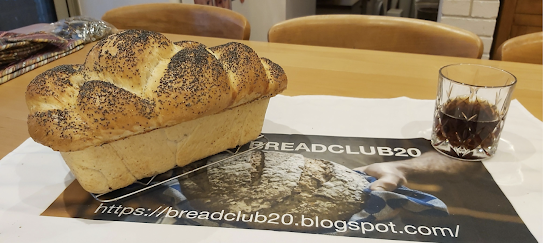Crusty White Three Strand Plait
Plaited loaves are always a show-stopper.
As winter comes ever nearer, imagine a tureen of tasty homemade soup and a crusty white plaited loaf on the breadboard next to it.
It makes a perfect lunch.
This is a straightforward recipe for a bread that will become a firm favourite.
INGREDIENTS
500 gms of strong white flour
300 mls of warm water
15 gms of unsalted butter
1 teaspoon of sea salt
1 teaspoon of caster sugar
7 gms of instant yeast
---------------------------------
1 beaten egg
Poppy seeds
---------------------------------
2lb loaf tin (approximately 23 cms x 13 cms) - If you don't have a loaf tin, you can always try your hand with free forming the dough on a baking sheet.
If you're handmixing, bring the flour, salt and sugar together in a large bowl. Rub in the butter and add the yeast. Slowly add the water into a well in the middle and mix until you have a soft dough. Knead for about 10 minutes on a floured board. Place in a lightly oiled bowl, cover with a tea towel and place somewhere warm for about an hour until the dough has doubled in size.
If you're using a machine, place the water, salt and sugar in the pan. Add the flour, butter and yeast and use a Basic Dough programme (about 2hrs 20 minutes)
When the dough is ready (whichever method you choose), knock it back to remove the air, weigh it, place it on a floured board and then divide it up into three equal parts. You can reweigh each part to be sure.
Mould the ball and roll to form three equal sausage shapes. They'll need to be about 30 centimetres long.
Arrange them on the board in the shape of an arrow, the point furthest away from you. At the 'point' of the arrow, just press down on the dough lightly to help the pieces to stay put.
Then, start plaiting the dough. Don't pull too much, just gently.....
left strand over the middle, then right strand over the middle, and so on.....
Another way is to number them from the left: 1, 2, 3
Then it's...
1 over 2 and 1 becomes 2
3 over 2 and 3 becomes 2
1 over 2 and 1 becomes 2
3 over 2 and 3 becomes 2.......and so on. (You'll work your own system, I'm sure)
Once all three strands have been plaited together, tuck the ends underneath the dough to hold the loaf in place.
Lightly oil the loaf tin and gently place the dough in the tin, trying to disturb it as little as possible.
Place it somewhere warm and leave for its second prove until it has doubled in size.
Preheat your oven to 200 degrees C.
Beat the egg and gently paint the top of the loaf. Then sprinkle with poppy seeds.
Bake in the oven for 30 minutes until the bread is a golden brown and it produces a hollow sound when tapped on the bottom.
Cool on a wire rack.
Happy baking.....
POSTSCRIPT
I have to say.....my loaf does remind me somewhat of Lady Campanla Tottington...
Next time, I'll second prove on a baking sheet. This is a three strand plait. Paul Hollywood has a recipe for an eight strand plait.
I find Rubik's Cube bores me to death....the thought of an eight-strand plait will probably finish me off.....
Unless, of course.....
Very happy baking....









Comments
Post a Comment